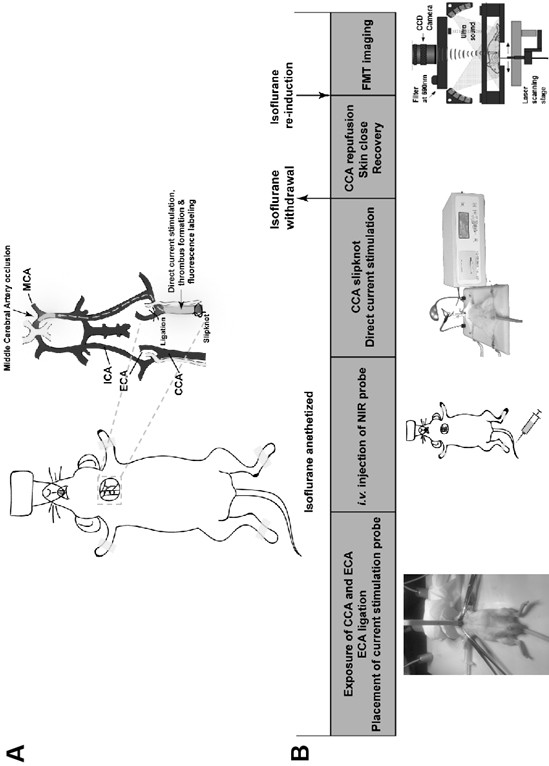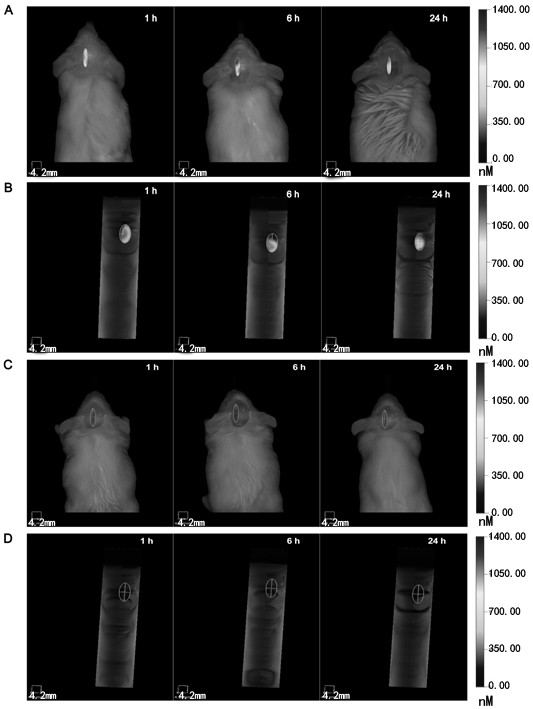Construction and evaluation methods of mouse ischemic stroke model
A technology for ischemic stroke and mice, applied in the field of biomedicine, can solve the problems of difficult clinical transformation and needs to be improved, and achieve the effect of close pathological mechanism, less trauma and high postoperative survival rate
- Summary
- Abstract
- Description
- Claims
- Application Information
AI Technical Summary
Problems solved by technology
Method used
Image
Examples
Embodiment 1
[0028] Example 1: Amphiphilic, positively charged near-infrared fluorescent molecules can be used as probes for thrombus in stroke patients
[0029] Thrombectomy was performed in patients with acute ischemic stroke, and the fresh thrombus was stored at -80°C. Frozen tissue samples were cut into 10 μm thin slices using a cryostat, pasted on a clean slide, and stored in a slide box at -80°C. The frozen tissue sections were taken out from -80°C and placed at room temperature for 10 min. After the sections returned to room temperature and dried, the OCT was washed with PBS and then stained. The fluorescent molecule ZnPc(Lys) 5 (3.5 μM) was added dropwise on tissue sections, incubated at room temperature for 2 h, and washed 3 times with PBS. After ZnPc(Lys) 5 The stained and labeled thrombus section samples were imaged under a laser confocal microscope with an excitation wavelength of 633 nm and a magnification of 10×.
[0030] see results figure 1 B, The results show that the t...
Embodiment 2
[0031] Example 2: Construction of a mouse model of ischemic stroke
[0032] After the mice were successfully anesthetized, they were fixed on the operating table in the supine position. The skin was prepared and disinfected routinely. A midline neck incision was made, and the glandular tissue and fascia of the neck were bluntly dissected, and the CCA and ECA were exposed and separated. The ECA was ligated at the bifurcation of the CCA, ECA, and ICA, and a thread was embedded at the proximal end of the CCA. The fluorescent probe (50 nmol / kg) was injected into the blood circulation through the mouse tail vein. After 5 minutes, the proximal end of the CCA was ligated, and the exposed CCA length between the two ligations should be about 13 mm. Hook the exposed CCA into the groove of the thrombus probe of the YLS-14B thrombogenesis instrument, gently lower the pressure plate, keep the thrombus probe perpendicular to the body of the mouse, fix the upper end of the probe on the brac...
Embodiment 3
[0034] Example 3: Evaluation of a mouse model of ischemic stroke using a small animal in vivo imager
[0035] After the operation, the mice were depilated from the skin of the brain and placed in a small animal live imager (FMT 2500 TM Real-time monitoring of ZnPc(Lys) in mouse brain in LXinstrument, PerkinElmer) 5 fluorescent signal. The instrument uses a 680nm laser diode to excite ZnPc(Lys) 5 Molecule, select the mouse brain as ROIs, scan 50-60 source positions (the distance between adjacent scanning points is 3 mm), and obtain the localization results of thrombus. At the same time, mice in the sham-operated group were used as controls.
[0036] see results image 3 , the brain of the affected side of the mice in the model group showed strong fluorescence, and the fluorescence intensity did not decrease significantly after 24 hours, indicating that the thrombus formed by direct current stimulation was relatively stable and could stably block the cerebral artery on the ...
PUM
 Login to View More
Login to View More Abstract
Description
Claims
Application Information
 Login to View More
Login to View More - R&D
- Intellectual Property
- Life Sciences
- Materials
- Tech Scout
- Unparalleled Data Quality
- Higher Quality Content
- 60% Fewer Hallucinations
Browse by: Latest US Patents, China's latest patents, Technical Efficacy Thesaurus, Application Domain, Technology Topic, Popular Technical Reports.
© 2025 PatSnap. All rights reserved.Legal|Privacy policy|Modern Slavery Act Transparency Statement|Sitemap|About US| Contact US: help@patsnap.com



